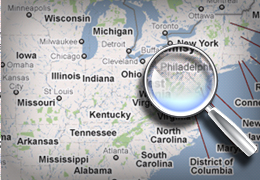
Locations of Uranium Recovery Sites Undergoing Decommissioning
To provide for the disposal, long-term stabilization and control of uranium mill tailings in a safe and environmentally sound manner, and to minimize or eliminate radiation health hazards to the public, Congress enacted the Uranium Mill Tailings Radiation Control Act of 1978 (UMTRCA). Under Title I of the UMTRCA, the U.S. Department of Energy (DOE) or the pertinent State is responsible for cleanup and remediation, as well as long-term care and maintenance of Title I disposal and processing sites, under a general license from the U.S. Nuclear Regulatory Commission (NRC). The NRC, in turn, is required to evaluate the design and implementation established by DOE or the pertinent State and, following remediation, to concur that the site meets the standards established by the U.S. Environmental Protection Agency (EPA). Title 10, Section 40.27, of the Code of Federal Regulations (10 CFR 40.27), "General License for Custody and Long-Term Care of Residual Radioactive Material Disposal Sites," is the governing regulation for these abandoned disposal sites. See the Title I site status summaries for additional detail.
Title II of the UMTRCA addresses uranium recovery operations, some of which have substantial quantities of tailings, at sites that are licensed by the NRC or its Agreement States. Title II amended the definition of byproduct material to include mill tailings, and added specific authorities for the NRC to regulate this new category of byproduct material at licensed sites, which include conventional uranium mills and in situ leach (ISL) facilities. The NRC's Office of Federal and State Materials and Environmental Management Programs (FSME) provides project management and technical review for decommissioning and reclamation of these Title II facilities, which are regulated under Appendix A to 10 CFR Part 40. Of the 24 Title II uranium recovery sites that are currently decommissioning, 11 are regulated by the NRC, and 13 are regulated by Agreement States. The following map depicts the locations of these Title II sites, while the tables below the map identify the NRC-regulated and Agreement State-regulated Title II sites and provide links to their descriptions, which include site status summaries, any major technical or regulatory issues, and the estimated date for closure of each site. For more information, see Uranium Mill Tailings or contact us if you have any questions or comments.
| Uranium Recovery Sites |
NRC-Regulated Uranium Recovery Sites Undergoing Decommissioning
| Name | Location |
|---|---|
| American Nuclear Corporation | Casper, WY |
| Bear Creek | Rock Springs, WY |
| ExxonMobil Highlands | Converse County, WY |
| Homestake | Grants, NM |
| Pathfinder – Lucky MC | Gas Hills Mining District, WY |
| Pathfinder – Shirley Basin | Mills, WY |
| Rio Algom – Ambrosia Lake | Grants, NM |
| Sequoyah Fuels Corporation (Environmental Review Link) | Gore, OK |
| Umetco Minerals Corp. | Gas Hills, WY |
| United Nuclear Corporation – Church Rock | Gallup, NM |
| Western Nuclear Inc. – Split Rock | Jeffrey City, WY |
Agreement State-Regulated Uranium Recovery Sites Undergoing Decommissioning
The site descriptions (site status summaries, major technical or regulatory issues, and estimated closure dates) for the following sites were provided by the respective Agreement States, and the NRC makes no claim regarding the validity of that information.
| Name | Location |
|---|---|
| Cogema Mining, Inc. | Bruni, TX |
| ConocoPhillips Company | Falls City, TX |
| Cotter Uranium Mill | Canyon City, CO |
| Cotter Schwartzwalder Mine | Golden, CO |
| Dawn Mining Company | Ford, WA |
| Everest Exploration, Inc. | Hobson and Dinero, TX |
| ExxonMobil Corporation | Three Rivers, TX |
| Homestake Mining and Pitch | Sargeants, CO |
| Intercontinental Energy Corp. | Three Rivers, TX |
| Rio Algom Uranium Mill | San Juan County, UT |
| Rio Grande Resources | Hobson, TX |
| Sweeny Mining and Milling | Boulder, CO |
| Umetco Uravan | Uravan, CO |

